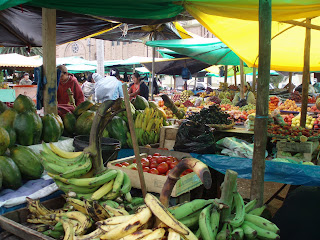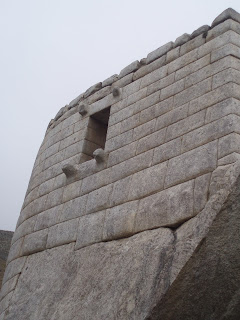 Friends, family, and countrymen,
Friends, family, and countrymen,- Me clutching a small receipt, entitling me to use the public toilet after having queued for ages and having paid my 10c.
- More market scenes! We loved the abundance of fresh fruit, veges, cheese, herbs, cooked beans and legumes, and meats! All ready to go!!
- More street scenes - including having my shoes cleaned by Alex, a young student. It´s his school holidays. He wanders the streets offering to clean peoples shoes for 5c. I have more to add to this small episode! Shoe-shiners are a very common sight in South America.
- A young lad, also on school holiday, pushing his trailor bike around the streets, selling fresh coconuts, home-made sweets, nuts etc!
- Two boys and their dog chasing a bobby calf. The animals are not enclosed in fences, instead (in Ecuador) they are tethered to a peg.
- Sitting in a crowded bus nursing a crying baby for a few minutes while her exhausted mother slept.
- Eating fried goat cheese.
- Drinking copious amounts of fruit juice - freshly squeezed while we waited: Tamirillo, papaya, orange, berry, pineapple, coconut - just to name a few!
- Argentinian wine.
- New adventures in every town.
- Peruvian beer.
- Being able to speak simple Spanish and be somewhat understood.
- People on the buses offering to help us as we appear very lost (we´re peering through the windows, looking around whilst referring to the Lonely Planet Guide)! We´ve also discovered the LPG is not always reliable.
- Stunning churches, and beautiful stained glass windows.
- The warmth and friendliness of people wherever we went.
- Fresh whole natural foods.
- The flower markets (Ecuador).
- Latino music - happy, upbeat and melodic.
- All the travellers who are coming to stay in Mahia.
- The wild-life - especially the llama, hummingbirds and flamingoes.
- Seeing the clothes the women from different parts of South America wear.
- Visiting the ruins of the Inca - an amazing, structured society.
- Dancing and music in the streets.
- The people, people, people, people, people!
Culture - thoughts addressed to Room 1 and 4.
(Maybe you could do a comparison against the NZ culture.)
I´ve been thinking..... What is Culture?! This has been a hot topic when meeting and talking with fellow travellers from Europe as their countries are facing many changes due to the huge movement of peoples to and from other countries - a massive mingling of cultures.
I know one can´t make an accurate assessment on a people in five minutes or even six weeks. However, in the short time I´ve been here I´ve made a few elementary observations based on my definition of CULTURE.
The following headings are elementary to a culture (I´m sure there are more).
- Food- how people grow, harvest and prepare their food. South Americans still grow and eat the same food they´ve eaten for hundreds of years. They have a huge agricultural and horticultural focus. They prepare the food in the traditional way- often in adobe brick kilns in their yard, or over a naked flame.
- Values. It´s been apparent as we´ve travelled that there´s a strong family focus. In the market places, on buses, in the streets we´ve seen families working, playing and walking close together. The people also have a very strong work ethic - it was common to see whole families working together in the fields, and at roadside stalls.
- Celebrations. The South American people love to dance and sing - we witnessed them celebrating Independence Day, weddings, and in street festivals.
- Music. The people continue to play the instruments that have been played for hundreds of years - pan pipes, rattles made from sheeps toe nails, charango (looks like a small guitar, the back of which is made from a amadillo shell), wooden flutes (recorder like), and drums made from cattle skin. It´s common to see groups of people playing together in the markets.
- Clothing. Most of the indigenous people continue to wear daily the clothing that has been worn by their families for hundreds of years. They take a lot of pride in their dress - we saw thisl throughout South America.
- Religious /Spiritual beliefs. The Catholic Church is central to the peoples life. 90 percent of the peoples adhere to the Catholic faith - introduced by the Spanish in the 1500s. Some peoples combine the Catholic faith with their early spiritualism, while peoples in the Amazon, still practise their primative faith - worship animals, plants, spirits, etc.
- Customs. We weren´t here long enough to observe their customs, however, what was evident was the importance of sitting and enjoying their food while talking with others.
- Songs, stories, myths and legends. Once again we weren´t here long enough to see these happening. However, I read that oral history is still alive , especially in the rural communities. As families work the land or move the animals, stories are told of how and where they came from - often linked back to the Inca. Myths and legends are told to teach principles and rules of a culture.
- Shelter - how communities live together. In the rural communities, the people help and support one another in their labours. In the cities, people live as we do in the west - in our own homes.
- That´s it!!!!!!
I look forward to seeing you all on Monday morning, going to give you all a ´whole lot of love´, especially Mr Tait!!!!!
Adios!


















 These three photos are typical rural scenes of northern Ecuador. They show:
These three photos are typical rural scenes of northern Ecuador. They show:





































